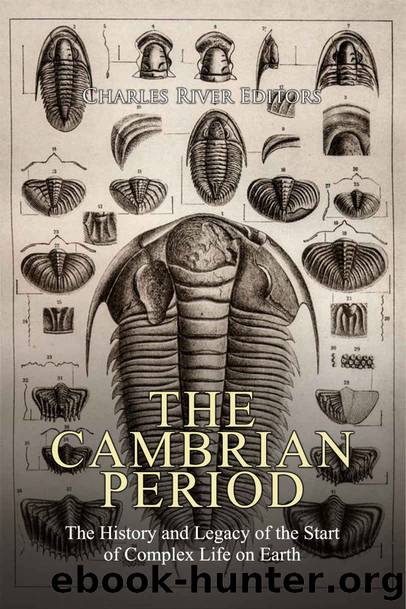The Cambrian Period: The History and Legacy of the Start of Complex Life on Earth by Charles River Editors

Author:Charles River Editors
Language: eng
Format: azw3
Publisher: Charles River Editors
Published: 2020-10-14T16:00:00+00:00
Cambrian Life Forms
Before discussing the creatures that appeared during the Cambrian explosion, it is important to understand some of the terminology involved.
A phylum is the highest level of classification for life forms on Earth. A phylum would be, for instance, a group of animals that share the same overall body plan. However, some animals are grouped under one phylum despite having wildly different outward appearances, because they are classified by internal similarities that enforce the notion that they are likely related.
Some might wonder why whales and giraffes are related, and it all has to do with the internal structure. Scientists suspect that the ancestors of both were terrestrial creatures and some of their offspring went back into the oceans, becoming whales and dolphins, while others remained on land, becoming giraffes.
In the animal kingdom, there are 34 known phyla. One of those is phylum Chordata, consisting of creatures with a spinal cord or dorsal nerve channel. Within this phylum, there are several classes, including fish, amphibians, reptiles, birds, mammals and the extinct non-avian dinosaurs.
Within the class Mammalia, scientists have well over a dozen taxonomic orders, including Primates (which contains humans) and Artiodactyla, which contains alpacas, antelopes, camels, cattle, deer, giraffes, goats, hippopotamuses, llamas, mouse deer, peccaries, pigs, and sheep.
By merely looking only at the outward appearance, one might look at tapeworms and earthworms and think that they are closely related because of their similar shape, but these two life forms occupy entirely different phyla.
With todayâs greater skill of genetic analysis, scientists are reworking their past ideas of existing phyla. The classification of life forms is still far from perfect. Many sources disagree on numbers and definitions, and many do a poor job of incorporating species that have gone extinct.
For most of the history of life form classification, scientists were concerned with immediate family members of a phylum, order, class, etc. To broaden the discussion, scientists have defined âstem groupsâ to refer to aunts and cousins of an immediate taxonomic clade. Stem groups are relations that originate with an ancestor prior to a familyâs earliest common ancestor.
Having this extra dimension in their conversations about Cambrian life forms makes it easier for scientists to discuss different possibilities.
Triploblastic refers to a common design found in many different types of life forms. This design consists of three key layers:
â¢Outermost - skin
â¢Innermost - gut (digestive tract)
â¢Middle - muscle and other internal organs other than the gut
Very few animals are not triploblastic - worms are, as are birds, fish, snakes, humans, and many others. Some of the creatures that are not triploblastic include jellyfish, sea anemones, and sponges. It is believed some of the earliest multicellular creatures may not have been triploblastic.
All animals that have left and right sides at any point in their development are considered to be bilaterian. Because of this left-right quality, such a creature necessarily has distinct bottom and top surfaces, and unique back and front ends.
All of the known bilaterians are triploblastic and vice versa. Some creatures, like sea urchins, sea cucumbers,
Download
This site does not store any files on its server. We only index and link to content provided by other sites. Please contact the content providers to delete copyright contents if any and email us, we'll remove relevant links or contents immediately.
| Africa | Americas |
| Arctic & Antarctica | Asia |
| Australia & Oceania | Europe |
| Middle East | Russia |
| United States | World |
| Ancient Civilizations | Military |
| Historical Study & Educational Resources |
Magic and Divination in Early Islam by Emilie Savage-Smith;(1197)
Ambition and Desire: The Dangerous Life of Josephine Bonaparte by Kate Williams(1088)
Operation Vengeance: The Astonishing Aerial Ambush That Changed World War II by Dan Hampton(987)
What Really Happened: The Death of Hitler by Robert J. Hutchinson(872)
London in the Twentieth Century by Jerry White(848)
Time of the Magicians by Wolfram Eilenberger(844)
Twilight of the Gods by Ian W. Toll(814)
The Japanese by Christopher Harding(803)
Papillon by Henry Charrière(796)
Lenin: A Biography by Robert Service(780)
The Devil You Know by Charles M. Blow(779)
Twelve Caesars by Mary Beard(769)
Freemasons for Dummies by Hodapp Christopher;(750)
The Churchill Complex by Ian Buruma(732)
Napolean Hill Collection by Napoleon Hill(706)
The Enlightenment by Ritchie Robertson(693)
Henry III by David Carpenter;(690)
Bohemians, Bootleggers, Flappers, and Swells: The Best of Early Vanity Fair by Bohemians Bootleggers Flappers & Swells- The Best of Early Vanity Fair (epub)(689)
The Rise and Triumph of the Modern Self by Unknown(660)
